 |
 |
Luxor is unique among the cities of the world. Wherever you tread, you feel you are experiencing the past and the present at one and the same time. There is hardly a place in the city that does not have a relic that tells of the grandeur of the Ancient Egyptians several thousand years ago. Luxor is the world's greatest open-air museum, filled with aweinspiring monuments of ancient civilization. |
Where does the name 'Luxor' comes from?
Luxor is part of ancient Thebes: the one hundred-gated city' as it was called by the renowned Greek historian, Homer, because of its buildings and large gates. The city grew over the years, and the Arabs, impressed by its beautiful palaces and huge edifices, re-named it Luxor: City of Palaces.
Luxor remained the seat of power from 2100 to 750 B.C. That is why the visitor is awed by the city, made immortal by its huge pillared-monuments along both banks of the Nile, in the City of the Living, in the east, where the life-giving sun rises; and in the City of the Dead, in the west, where the sun, in its never-ending orbit, bids farewell to life! |
|
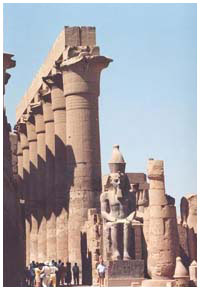 |
 |
Temple of Luxor: |
| Built by the two pharaohs: Amenhotep III and Ramses II. The temple was dedicated to Amun-Ra, whose marriage to Mut was celebrated annually, when the sacred procession moved by boat from Karnak to the Luxor Temple. The entrance is a huge pylon built by Ramses II and has two seated statues of the king. Originally, two large obelisks stood in front of the pylon. However, only one remains, while the other now stands in Place de Ia Concorde, in Paris. Beyond the pylon, is the peristyle hall - built by Ramses II - and bordered on three sides by double rows of columns with bud papyrus capitals. In the north-eastern part of the hall is the Mosque of Abul Haggag. The rest of the Temple was built by Amenhotep III, starting with the Colonade that has fourteen hug pillars in two rows. Seated statue of Ramses II. Then we come to the large Court of Amenhotep III that is surrounded on three sides by double rows of pillars. This leads to the hypostyle hall, containing 32 pillars, and on to the Sanctuary of the Sacred Boat. Alexander the Great built a kiosk within that of Amenhotep III. Finally, we reach the four-columned Holiest of Holies: the Sanctuary of the Sacred Statue. |
| |
|
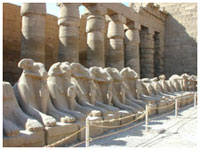 |
Karnak Temples:
This is the greatest place of worship in history. It includes many singular temples, dedicated to Amun, his wife (Mut), an their son (Khonsu), the moon deity. Since the Arab conquest, it became known as Oal-Karnak': the Fort.
The temple starts with the Avenue of the Rams, representing Amun: symbol of fertility and growth. Beneath the rams’ heads, small statues of Ramses II were carved. The colossal statue of Pinedjem in the first courtyard.
|
| |
|
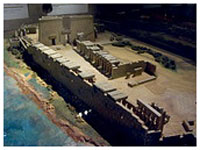 |
Colored Canyon:
We start our visit to Karnak by passing through the First Pylon, dating to King Nekhtebo of the 30th Dynasty, on to the large forecourt where on the right we find the chapels of the Thebes Triad, dating to Seti 11. On the left, there is the Temple of Ramses Ill. Then comes the remnant of the Second Pylon, which leads to the large hypostyle hall, which has 134 columns, with the double row in the middle higher than the rest. We then come to the remnants of the Third Pylon, before which stands the obelisk of Thutmosis I, and on to the Fourth Plyon, guarded by the obelisk of Hatshepsut. Beyond, are the remains of the Fifth Pylon, leading to the Holiest of Holies. We finally come to the court, from the Middle Kingdom, which leads to a large Hall of Ceremonies, dating back to Tuthmosis III.
|
| |
Top |
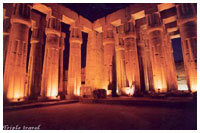 |
The Sacred Lake:
The Sacred Lake, used for purification, lies outside the main hall where we have a large statue of a scarab, dating to King Amenhotep.
The Sound and Light Spectacle:
This spellbinding show, through the exquisite use of words, light and music, tells the story of this magnificent temple. The programme is presented twice daily in Arabic, English, French and German. |
The Luxor Museum:
The Museum is situated between the Temples Of Luxor and Karnak. It houses pharaonic relics from Luxor and the nearby areas. The picture on the right displays how illuminating the museum is at night. |
| |
| |
 |
|
Tourist Attractions On The West Bank Of The Nile: |
The Colossi of Memnon:
The only remnants of a temple commemorating Amenhotep Ill, these statues are 19.20 meters high. When they suffered cracks, and where said to sing, the Greeks named them after Memnon, the legendary hero killed at the Trojan Wars, who, each morning, called his mother Eos, the Dawn goddess, and she bewailed him, shedding tears that were the dewdrops.
Commemorative Temples. |
| |
|
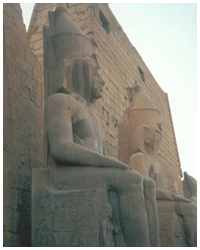 |
The Tombs of the Valleys of the Kings and Queens:
These are the two tombs, ordered by the kings and queens of the New Kingdom to be carved in the rock-faces of the valley so as to safeguard them against grave-robbers. The tomb is composed of several rooms and corridors leading to the Burial Chamber. The chief tombs of the Valley of the Queens are those of: Queen Nefertari, wife of Ramses II (shown to the left) |
 Top
Top |
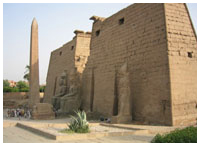 |
|
The most important of these tombs are those of:
1) Tut-Ankh-Amun III 2) Ramses Ill 3) Seti I 4) Ramses VI 5) Amenhotep II
6) Hur-Moheb 7)Tuthmosis III
Deir el-Bahari Temple:
This temple was built by Queen Hatshepsut to perform the rites of the nether world. Deir el-Bahari is a fairly recent nomenclature from the 7th century B.C. when the Copts used it as a monastery. The Temple is composed of three impressive rising terraces, split by a road.
The Ramesseum:
built in commemoration of Ramses II, its murals record the Battle of Kadesh. |
| |
|
 |
Madinet Habu Temple: |
| built in commemoration of Ramses Ill, characterized by its well-preserved religious and military scenes. These paintings still retain their vivid colors. |
|
| |
|
 |
The most important tombs of the area are:
Tombs of the Nobles: portraying the lives of nobles and their families.
The Tomb of Nakht: the inscriptions portray the skill of the Egyptian artist.
The Tomb of Menna: scribe of the fields of the Two Lands, during the reign of Tuthmosis IV.
The Tomb of Ramose: one of the state officials during the reign of Amenhotep III and Akhnaten. The tomb contains inscriptions depicting Akhnaten and his wife, Nefertiti.
The visitor to Luxor may also see the Temples of |
|
|
|
Top |
Dendera and Esna:
Temple of Dendera: This Graeco-Roman temple lies about 60 kms north of Luxor. The temple was first initiated by Ptolemy III with numerous additions by subsequent Roman Ptolemic rulers. It houses a famous painting of Queen Cleopatra, and Caesaron, her son from Julius Caesar. The temple is renowned for its horoscope inscriptions.
Temple of Esna: Located south of Luxor, the temple has a hypostyle hall with pictures and texts telling of the Roman emperors who came to Egypt and offered sacrifices to its deities. |
|







